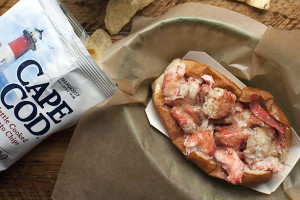Meet Colin Gasko, the Rogue Chocolatier

Colin Gasko, surrounded by his highly coveted chocolate bars. / Photo by Webb Chappell
On the package of Rogue Chocolatier’s “Jamaica” bar is a quote attributed to German architect Mies van der Rohe: “God is in the details.” It’s an old aphorism that Rogue founder Colin Gasko took to heart: His single-minded perfectionism has chocolate experts like Clay Gordon calling the 30-year-old Worcester native the country’s best chocolate maker. Even laypeople can’t resist Rogue’s small-batch, single-origin bars, which local stores like Cambridge’s Formaggio Kitchen struggle to keep in stock.
So what makes Gasko’s chocolate stand out from its bean-to-bar brethren? For one, Gasko procures cocoa from single-farmed lots in up-and-coming regions such as Jamaica and Ecuador—rare, terroir-driven provinces that are still relatively untapped. Then there’s his painstaking process, which takes far longer than his competitions’; just the roasting and molding alone can take a month to complete.
But the devilish attention to detail has paid off. Rogue’s starkly ornamented chocolate bars have racked up a trophy case of awards, making it one of the top brands in North America, if not the world. The Good Food Awards honored the company as one of America’s best chocolate brands each year from 2011 to 2014. And this summer, Rogue’s “Porcelana” bar picked up a coveted gold medal at the International Chocolate Awards.
Not bad for what started as an “expensive hobby.” While Gasko was working at a Minneapolis Whole Foods in 2006, his boss taught him how to make rolled truffles. His curiosity piqued, he purchased a small stone spice grinder and began roasting chocolate in an oven he hacked together with a box fan and hair dryer.
Despite the limitations of his basement operation—with cocoa beans ground by hand on a rickety clothes dryer—Gasko was onto something. Soon he invested in better equipment and a rented production space, and in 2008 his bars caught the attention of Martha Stewart, who toured his Minneapolis facility for her television show.
Now headquartered in Three Rivers, Gasko is still Rogue’s sole employee. His partner, Viva Butler, occasionally assists with roasting, though Gasko prefers to work alone. His standards are exacting, but that isn’t the only motivation behind his self-inflicted isolation. The proprietary nature of his craft is such that his production facility is now off-limits—not just to reporters and photographers, but to most friends and family as well.
Despite all the awards, Gasko says that in terms of production, Rogue has “not grown at all, ever.” After all, when he spends at least 45 days aiming for perfection, one batch of bars at a time, scaling up is difficult.
“We have grown the quality of what we’re doing over the years, which is the most important thing,” he says. “That’s what makes it a craft—there’s a craftsman behind it.”
From Bean to Bar
A glimpse into the precise steps behind Colin Gasko’s single-origin chocolate bars:
1. Gasko sorts cocoa beans by hand to remove any stones, sticks, clumps, or germinated seeds.
2. Beans are roasted in a convection oven, then cooled.
3. Gasko uses a machine he designed and built himself to remove hulls from the seeds of the roasted beans.
4. Nibs, or winnowed cocoa fragments, are ground with cane sugar into a liquid paste with a final particle size of less than 20 microns.
5. The next mixing process, called conching, optimizes the chocolate’s texture, flow properties, and flavor, and can take one to three days.
6. Smooth, liquid chocolate is poured into custom molds, cooled, and then packaged.


